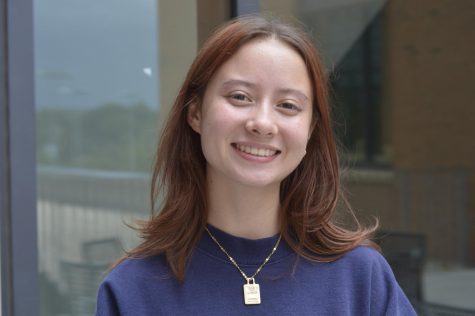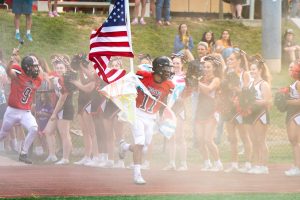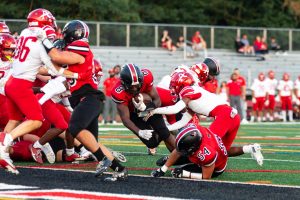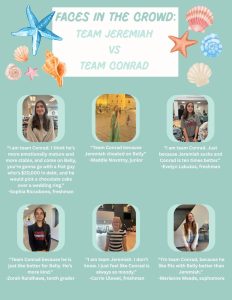For The Record: Taylor Swift’s “Red” (From The Vault)
November 17, 2021
Red (Taylor’s Version) was released less than a week ago, and song lyrics, theories, and thoughts are rapidly through the minds of many on The Lasso staff. Keep checking our website — we have lots of feelings and we’ll be sharing them. Audrey Morrison starts off reviews with an in-depth exploration of “From the Vault” songs of the new album.
With Taylor Swift’s second re-released LP, “Red (Taylor’s Version),” we watch as she lays down another brick in the restoration of her opus. After an ugly, highly publicized ownership battle, Swift’s former manager, Scooter Braun, remains proprietor of most of her work. In an adept act of defiance, Swift decided to re-record her first six albums. Few know (but many guess) which album she plans to unleash upon her loyal fans in the subsequent months. For now, let’s enjoy “Red (Taylor’s Version).”
The timing for the album’s renaissance couldn’t be more perfect. “Autumn leaves falling down like pieces into place, and I can picture it after all these days.” Lines from Taylor’s heart-wrenching soliloquy, “All Too Well,” reflect upon her experiences in fall 2011, yet flawlessly encapsulate our modern circumstances. The song is somber, reminiscent of a warmer, spotless frame of mind. As Taylor releases these well-loved, well-worn tracks, she taps into a mood which, like the seasons, changes swiftly. “Red” invokes hope, grief, retribution, infatuation, and satire all within a neat two hours and ten minutes. We catch a glimpse of a twenty-something Taylor racing from party to party, first love to first fight, small town to metropolis. Taylor’s version desires more.
Although the contents of the re-release is essentially the same (excluding the vault tracks), the sound and technicality of Taylor’s version far surpasses its predecessor. The overall sound is cleaner, brighter, and more self-assured. Swift takes to particular, intimate musical decisions and progressions. Guitar riffs which were subdued and folk-like in the original track, “Holy Ground,” are amped up and bold. It’s scrubbed clean of hesitation; it’s just Taylor and her memories to be reckoned with. Although Taylor’s version lacks some of the time sensitivity and raw emotion which characterized its prototype, it feels, more than ever, that she has grown and found strength in her voice. She doesn’t have to strain to hit notes or crack her voice, she just lets the story speak for itself.

There isn’t much more to say about Taylor’s original setlist, but her newly uncovered tracks, “From The Vault,” are definitely worth exploring. The first song of note from the stronghold is Swift’s collaboration with Phoebe Bridgers on “Nothing New.” Some fans were apprehensive of the hidden gem due to Swift’s history of concealing female vocals as backtracks (hence, the Maren Morris effect), but I’m happy to say that she really delivered for this one. Phoebe was the perfect fit for this track. Their subdued, husky vocals ghost in and out, melding perfectly. The harmonies, the strings, everything is heavenly. Even the prose seems seamlessly tailored for the duo. “Nothing New” could live amidst Phoebe’s most recent retinue. The song shares the same fears of growing pains, social drinking, and feelings of inadequacy which float through Phoebe’s 2020 LP “Punisher.” Simple, yet haunting and direct, “Nothing New” has the foresight of an eternally wise, deeply frightened perfectionist. She has to be psychically inclined to have written lyrics which ring so blaringly true to this generation’s wave of self-effacing, over-achieving artists.
Taylor’s “From The Vault” track, “Babe,” echoes the prototype of “Red” but with shiny, improved accessories. There’s those strong, building bridges which Taylor is notorious for, but with percussion and brass. She’s able to add another layer of distinction. “Babe” is beat heavy and acoustic all at once, reminding me of Gotye and Kimbra’s 2011 hit, “Somebody That I Used to Know”. The content and beat is very 2012 era “Red” but the brass is something altogether different. I’ve been noticing more and more brass progression in Taylor’s discography since around 2020. This could be, in part, because of her collaboration with Big Red Machine’s Bon Iver (Justin Vernon) and Aaron Dessner (of The National) on her 2020 LPs “Folklore” and “Evermore.” The trumpets add depth and seem to fill the song with space. By lifting the heavier, more monotonous beat, the brass relieves the song of its bitterness. “Babe” is celebratory and wistfully reminiscent.
If Taylor Swift is best at anything, she’s terrific at throwing us for a loop. The song from Taylor’s annals of history, “Message in the Bottle,” is no different. It’s surprisingly afrobeat? And there’s a ton of synth? What’s going on? If I could describe this song in three words, they would probably be “lit,” “crazy,” “movie.” Personally, this track isn’t really my cup of tea, but after a few more listens, it’s starting to grow on me. It’s very “Call Me Maybe,” Carly Rae Jepson, Kelly Clarkson, pop perfume ad. I could see myself dancing to this at a sleepover circa 2012.
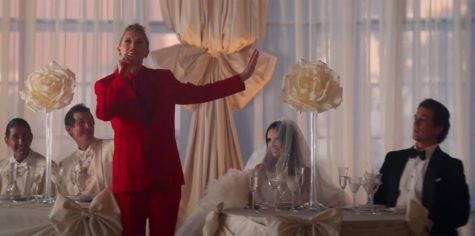
Taylor Swift and bluegrass crooner Chris Stapleton’s collaboration, “I Bet You Think About Me” is kind of ironic as well. Twangy and piano-laden, Swift sings about being a small girl in the big city for the first time. It’s funny and balladic, if not slightly self-deprecating. Swift’s brand during the noughties and early 2010’s was characterized by the charming tractor, folky pop sound and a small town, big dreams kind of ambition. That’s why listening to this track is sort of like cognitive dissonance. There’s a difference between singing ode to your roots and outright reliving them. This is where Taylor sort of falls out of touch with her image. Still, I think it’s a pretty good narrative. It’s cutting and witty, directly referencing a former lover who seems to value a sort of meaningless, vagrant way of life over common sense. Swift sardonically picks at his “organic shoes” and how she bets how he thinks about her at his “cool indie concerts every week.” Taylor, you’re literally best friends with Lorde and Haim. How much more “cool indie concert” can you get?
Horns! Slide guitar! Bells! Winter! Longing! Regret! So sad! I can only seem to punch out monosyllabic or disyllabic words when I hear this song. You can feel how much more she wants to say, but Taylor holds back. I’m not going to speculate who I think this song is about because she is adamant on making her music interchangeable with every listener’s experience. But I have a feeling that this song was difficult for her to write. The prose is bittersweet, a motif which Taylor seems to take on for many of her more Christmas-y songs. Like “Christmases When You Were Mine” and “Best Day.” The album’s uncovered track, “Forever Winter” is bracingly cold and sentimental. I like this subversion because it only makes the song more meaningful when you consider the context and timing of her work. I think that “Forever Winter” has the possibility of becoming a Great in Taylor’s winter setlist, alongside the likes of “Back to December” from “Speak Now” and “ivy” from “Folklore.”
Taylor’s voice on “Run (feat. Ed Sheeran)” is lovely! And Ed is… there. It’s not that he’s terrible! He just feels a bit out of place. “Run” is paced, with acoustic guitar and syncopation similarly reminiscent of Big Red Machine. Taylor’s part is soft and clear, falling in and out of focus while the accompaniment remains strong. Because of her ability to hold her own and command space, Ed’s sound comes off as a bit thin and reedy compared to Taylor. If I were to critique this track a bit more, I would suggest a bit more build. It feels like it’s going somewhere, then it just sort of… fizzles out. Closing remarks: a little more build, a little less Ed (respectfully).
The second to last track from the vault, “The Very First Night,” is making me fall in love with the“Red” era all over again. Reminiscing a whirlwind romance, the song pivots through a relationship set in the city. It’s unnervingly catchy, Owl City-esque chorus is seeped with nostalgia. “I wish I could fly. I’d pick you up and we’d go back in time. I’d write this in the sky. I miss you like it was the very first night.” There’s also an interesting rhyme change which many Swifties caught on to early on in its release. “But don’t forget about the night out in L.A. Dance in the kitchen, chase me down through the hallway. No one knows about the words that we whisper. No one knows how much I miss you.” Most of verse two follows the same rhyme scheme (first line ending with “hallway” and second line ending with the rhyming ‘L.A.’), but the rhyming pair for “whisper” would seem to be “miss her.” By intentionally creating that discordance, we can infer that she wants to keep the details of the relationship secret (using suggestive language like “whisper”), while also enticing the listener to search for meaning within the song. We may never know what she’s talking about, but boy is it nice to listen to.
Finally, the one we’ve all been waiting for: “All Too Well (Ten Minute Version).” Wow. It feels like I’m finding the lost and charred remains of the Library of Alexandria. What a wealth of experience! The ten minute version is acutely personal and much more dark than her younger sister. It gives us so much more insight into her relationship with [redacted]. With the addition of about five minutes, the length gives the song much more room to grow. Each pre-chorus strengthens the bridge and chorus build, summoning a pain which has been long buried to rear its woeful head. There’s less of the initial rage in the studio release, less of the blaring, soaring electric guitar. It’s filled with vocal adlib and warm horns, giving the ten year old tune a more folkloric atmosphere. She’s laying the tale to rest in the only way she knows how: through rhyme and verse.
Disclaimer: “Better Man” was not explored in this analysis because I don’t believe it’s of note.



